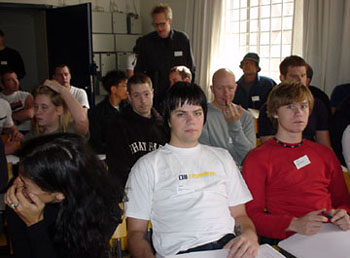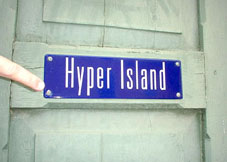PROJECT 40
HAPPENINGText: Matt Owens
After all the teams presented their concepts, the big question was “what do we do next.” Many participants were outraged that so much preparation was put into Project 40, but no planning was put into how the individual projects might contribute to the AIDS cause after Project 40 was over. Through discussion, it came to light that Hyper Island makes no real claim to Project 40 and that it was the sole responsibility of Lisa, Henrikk, Maria, and the rest of us to see the project through. Understandably, Lisa, Henrikk and Maria were exhausted by the end of Project 40, having coordinated everything prior and during the 4 days.
It still seems very short sighted of Hyper Island to be so inconsiderate to their students as to not provide more institutional support, a teacher or board member to ensure that something beneficial was done for the AIDS cause as a result of Project 40.

After much debate, the three coordinators, participants, and speakers agreed that putting together the four concepts and presenting them to the UNAIDS organization as proposals for potential strategies to address the AIDS crisis online and offline made sense. Though all of the projects were not fully thought through, there were many good ideas that arose and could spark debate about what can be done to address the crisis specifically in Africa. The concepts are a reflection of time constraints, limited knowledge, and an often naive western european mindset. For these very reasons, the projects are valuable. They are both a reflection of our own ignorance as to the real issues dealing with AIDS and HIV and our desire to use our talents as a global design community to in some way contribute to a very real global problem. By presenting the projects to the UNAIDS organization, they will provide a social snapshot of the thinking of the online design community, spark debate, and hopefully the realization of a digital strategy. Many participants and speakers are committed to continuing the project and to donating time and resources to further develop these ideas with the coordination of the UNAIDS organization. The projects are merely sketches that will require more time and research to be fully realized.

The fact that Lisa, Henrikk and Maria dreamed up Project 40 and made it a reality cannot be over congratulated. As students, they went above and beyond the call of duty to contribute to the interactive design community in a real and immediate way. Putting a global representation of interactive designers together to address a global problem can only be amazing, and they are to be commended. Over the course of Project 40 we were able to understand each other in a non-corporate, non-conference setting that allowed us to see each other as individuals, the people behind the work.
Where does Project 40 go from here?
I think Lisa, Henrikk and Maria have created something really amazing in Project 40 and I think it is a challenge to another set of students, in an interactive or design department out there somewhere, to contact Lisa, Henrikk and Maria and to say “We want to take on the next one.” As a student-initiated, non-corporate experiment in collaboration, Project 40 is a physical representation of the what the online community desperately needs, human interaction and collaboration on both and intimate and global scale.
Project 40
Date: May 27th – 30th, 2000
Place: Hyper Island
Address: 14 Bastionsgatan, S-371 32 Karlskrona, Sweden
Tel: +46 455 30 7777
https://www.project40.com
Text: Matt Owens
Photos: Matt Owens




